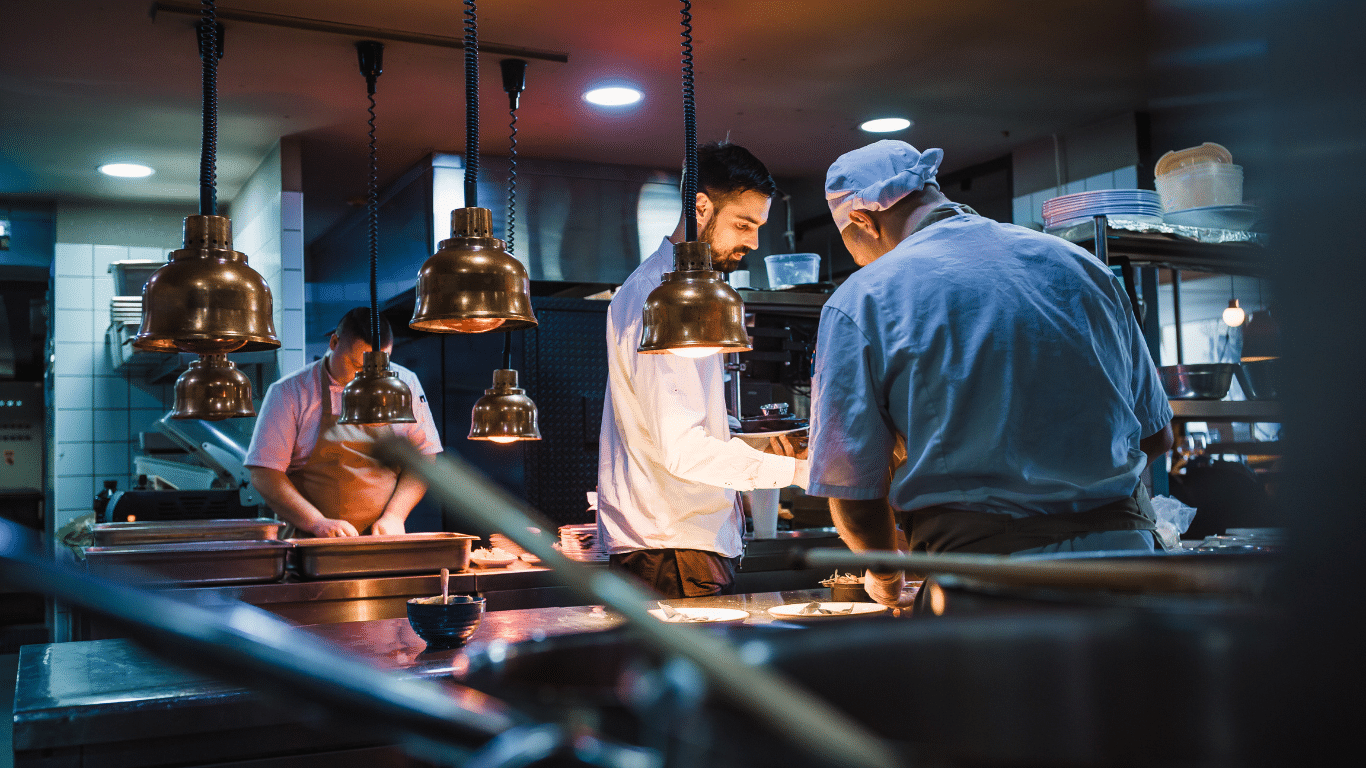
Conducting a market analysis is a fundamental step any entrepreneur should take before establishing or expanding a restaurant business. It involves a deep dive into understanding the various elements that could influence the success of a restaurant.
By delving into market analysis, you unlock a comprehensive understanding of market size, growth potential, latest trends, and consumer behavior. Engaging in a detailed SWOT analysis, Porter’s Five Forces, and competitor scrutiny empowers you to make informed, data-driven decisions that not only meet but surpass market demands.
A thorough market analysis also encompasses the evaluation of the competitive landscape. It’s not just about the customers but also who else is serving them. I look at direct and indirect competitors, comparing their strengths and weaknesses to find unique positioning for my restaurant. Additionally, keeping an eye on industry trends and changes in the regulatory environment helps me to stay ahead of the curve. Operational insights, such as the impact of locations and supplier options, contribute to creating a comprehensive picture that guides the strategic direction of the restaurant’s concept, menu creation, and service model.
Key Takeaways
- Market analysis guides my decisions, ensuring they are aligned with customer demand.
- Evaluating competitors allows me to position my restaurant uniquely in the market.
- Staying informed on industry trends and regulations helps me maintain a competitive edge.
Market Overview
When assessing the landscape of the restaurant industry, I find it crucial to consider both the current scope and the expected expansion. Detailed market research plays an integral role in understanding these elements.
Market Size
Currently, the restaurant industry boasts a substantial market size, a testament to a thriving sector that continues to evolve and adapt post-pandemic. This vibrant market includes a diverse array of establishments, from quick, convenient fast food to the luxurious appeal of fine dining.
In the United States, restaurants are a significant contributor to the domestic economy and have become an international symbol of American culture, with many U.S. restaurant chains enjoying fame worldwide. Notably, the U.S. Quick Service Restaurant (QSR) industry is projected to see a remarkable increase, with forecasts predicting an output rise of approximately 111 billion U.S. dollars over fifteen years, culminating in 275.7 billion U.S. dollars by 2022. Similarly, the output of the U.S. full-service restaurant industry has witnessed substantial growth, reaching an estimated 76.5 billion U.S. dollars in 2022.
Beyond economic contributions, restaurants hold a central place in American personal and professional life, reflecting cultural values and trends. The industry also plays a critical role in employment, with around 12.5 million individuals working in various capacities within the U.S. restaurant sector as of 2022. This number signifies the vast dependency on the hospitality industry for livelihoods, from kitchen staff and servers to management and entrepreneurial roles.
Industry Trends

The restaurant industry is experiencing a wave of transformation, continuously shaped by evolving consumer preferences and global influences. Here are more detailed insights into the current trends and additional emerging patterns that every market analyst and industry participant should watch:
Health and Wellness Focus
Consumers are increasingly health-conscious, leading restaurants to offer more nutritious and well-balanced meal options. There’s a growing trend towards clean eating, with menus highlighting organic, non-GMO, and low-calorie options. Plant-based diets are on the rise, and as a result, there’s an increase in vegetarian and vegan menu items, even in traditionally meat-centric eateries. Incorporating superfoods and offering customizable, diet-specific meals are becoming standard practices to cater to this health and wellness trend.
Ghost Kitchens
A significant shift in the foodservice sector is the rise of ghost kitchens, which are commercial cooking spaces used by multiple restaurants for delivery-only services. This model reduces operational costs and allows both established restaurants and new players to experiment with minimal risk. Ghost kitchens are particularly advantageous in densely populated urban areas where rent is high and space is limited. They leverage the growing demand for food delivery services, fuelled by partnerships with apps and online platforms.
Cultural and Authentic Experiences
There is a noticeable desire among consumers for authentic and cultural dining experiences. People are looking for more than just food; they want stories, traditions, and experiences. This trend has led to the resurgence of traditional cooking methods, use of indigenous ingredients, and menus that offer a journey through a particular region’s culinary landscape. Restaurants are not only embracing diverse cuisines but are also focusing on authenticity and storytelling as part of the dining experience.
Digital and Interactive Menus
In an increasingly tech-driven world, restaurants are turning to digital and interactive menus to enhance customer engagement. These menus can provide detailed descriptions, origins of dishes, and even suggest pairings, elevating the dining experience. Some incorporate augmented reality to visualize dishes before ordering, helping diners make informed choices and reducing order errors and food waste.
Social and Environmental Responsibility
Beyond sustainability in food sourcing and waste management, restaurants are becoming more socially and environmentally conscious. This includes addressing the broader impact of their business, from fair labor practices and supporting local communities to reducing plastic use and improving recycling systems. Consumers are more likely to patronize businesses that reflect their values, making corporate social responsibility crucial for attracting and retaining customers.
Customization and Personalization
Customization is not a new trend, but it continues to evolve with technology. Consumers expect the ability to customize their meals, whether it’s for dietary restrictions or personal preference. Technology is making it easier for restaurants to offer personalized experiences at scale, from customizing menu items when ordering online to remembering previous orders and preferences for returning customers.
Experience-Driven Dining
Finally, the concept of experience-driven dining continues to expand. This includes themed restaurants, pop-up experiences, chef’s table events, and immersive dining, where the meal is part of a larger story or experience. Restaurants are becoming destinations offering unique and memorable experiences that go beyond food, incorporating elements of entertainment, education, and personalization.
By understanding and adapting to these trends, restaurants can position themselves effectively in a competitive market and cater to the evolving tastes and expectations of their customers. The key for success lies in balancing innovation with authenticity, leveraging technology while providing a human touch, and continuously listening to and learning from consumer feedback.
Consumer Analysis

In my experience, understanding who your customers are is pivotal for the success of a restaurant. This section expounds on the different aspects of consumer analysis, detailing demographic breakdowns, consumer preferences, and spending patterns which are essential for tailoring offerings to market demands.
Demographic Breakdown
Understanding demographics is essential to tailor a restaurant’s offerings and ambiance. It’s not just about age or income; lifestyle, cultural background, and even employment status can influence dining preferences. For instance, working professionals may prefer quick lunch options or establishments offering Wi-Fi and a conducive environment for meetings. On the other hand, retirees might value a relaxed atmosphere and senior discounts. By segmenting the customer base and understanding the unique needs of each segment, restaurants can create targeted marketing strategies and menu designs.
Consumer Preferences
Consumer preferences are shifting more rapidly than ever, influenced by social media, dietary trends, and a growing awareness of health and environmental issues. For example, the rise in vegetarianism and veganism has led many restaurants to expand their plant-based offerings. Moreover, the demand for experiential dining has grown, with consumers seeking not just a meal, but a memorable experience, whether it’s through themed decor, interactive meal preparation, or live entertainment.
Spending Patterns
Recent surveys indicate changing dining out patterns among U.S. adults, with many reducing their frequency of restaurant visits and opting for cheaper menu items due to economic constraints. The need for value is driving the success of promotional deals and loyalty programs. Understanding these shifts is critical for pricing strategies, menu planning, and promotional offers. In the fast-food or QSR sector, despite a temporary dip in 2020, spending has reached an all-time high, indicating a resilient demand for convenient, cost-effective dining options.
Dining Out Trends
According to a 2023 survey, there has been a notable decrease in the frequency of dining out, with 55% of U.S. adults eating out less at full-service restaurants and 45% at fast food establishments compared to six months prior. This trend reflects broader economic concerns and a shift in consumer priorities. However, the data also indicates that promotional deals could be a powerful tool to encourage more frequent dining out, with 54% of respondents suggesting they’d be persuaded by such offers.
Restaurant habit changes made by consumers:

Fast Food Sector Insights
The fast food or QSR sector continues to be a significant component of the dining industry, with consumer spending in the U.S. reaching around $320 billion in 2022. This suggests a robust and growing market segment that values speed, convenience, and affordability. Despite economic fluctuations and health trends that briefly dampened growth, the sector’s resilience is evident in its steady recovery and growth. Understanding consumer spending in this sector can help inform strategic decisions for businesses looking to tap into or expand within the fast food market.
Competitive Landscape

In the restaurant industry, understanding the competitive landscape is critical for success. It involves the analysis of market competitors and their impact on any venue, whether it’s a fast food chain or a full-service restaurant.
Key Players
Identifying the key players in the restaurant market involves scrutinizing who is currently leading the industry. In the context of fast food, global chains with expansive menus and efficient service models dominate the sector. When it comes to full-service restaurants, leaders often distinguish themselves through exceptional dining experiences and high-quality ingredients. Conducting a competitor analysis guide helps me to ascertain who these key players are and what strategies they use.
Market Positioning
How a restaurant is positioned in the market is crucial for attracting the right customers. For a fast food outlet, competitive pricing and convenience are often central to its market positioning. Alternatively, a full-service restaurant might prioritize its ambiance and culinary expertise. Utilizing tools like Porter’s Five Forces enables me to better understand the forces shaping market competition and helps determine your restaurant’s position within this landscape.
Niche Markets
Exploring niche markets can offer opportunities to tailor specific aspects of the restaurant experience to meet unique customer needs. Perhaps my focus on organic ingredients appeals to health-conscious diners, or maybe my restaurant’s commitment to cultural cuisine attracts those seeking authentic experiences. Insights from SWOT analysis enable me to identify these niches and evaluate how my restaurant can fill gaps in the market, especially within niches underserved by major players.
Explore our detailed guide on SWOT Analysis for restaurants Post
Operational Insights

When I conduct market analysis for my restaurant, operational insights play a crucial role in enhancing efficiency and streamlining service delivery. Here, I’ll focus specifically on the supply chain intricacies and cost management strategies that are essential components of food service optimization.
Supply Chain Analysis
In my experience, Supply Chain Analysis is a critical aspect of restaurant operations that ensures the availability and quality of ingredients critical for menu offerings. I closely examine supplier relationships, delivery schedules, and inventory turnover rates. For instance, my analysis often reveals that forming strategic partnerships allows for more favorable pricing and dependable delivery, which in turn improves the restaurant’s operational efficiency and customer satisfaction. Here’s a quick breakdown:
- Supplier Relationships: Increased collaboration for better quality control.
- Delivery Schedules: Timely deliveries ensure fresh supply without overstocking.
- Inventory Management: Regular checks minimize waste and reduce costs.
Cost Management
Effective Cost Management is vital for the profitability of any food service establishment. I meticulously monitor direct and indirect costs to identify savings opportunities while maintaining the quality of service. This often involves:
- Direct Costs:
- Food Ingredients: Negotiating better prices without compromising on quality.
- Labor: Adjusting staffing according to demand to control wage expenses.
- Indirect Costs:
- Utilities: Implementing energy-efficient appliances to cut down on electricity bills.
- Maintenance: Regular upkeep to prevent costly repairs and prolong equipment life.
Through meticulous cost management and proactive supply chain analysis, I ensure that my operations are not just surviving but thriving, even in a competitive market.
Product and Service Analysis

In my analysis of products and services within the foodservice industry, I focus on dissecting the variety and distinctiveness of menus, as well as the range and quality of service offerings. I aim to illuminate how these factors are pivotal in the success of restaurants, bars, and coffee shops.
Menu Diversity
The menu I craft is the cornerstone of my restaurant’s identity. It’s essential that the menu reflects both the concept of my establishment and the preferences of my target demographic. In the case of boutique coffee shops, for instance, offering a variety of coffee options, from classic espresso to artisanal brews, caters to various customer preferences. In addition, having a selection of pastries and light bites can be a significant draw. For bars, a balance between innovative cocktails and classic drinks, along with a succinct selection of snacks or small plates, can set my establishment apart from competitors.
Service Offerings
The service model I employ is as crucial as my menu. Quick service restaurants hinge on speed and convenience, aiming to serve customers promptly without sacrificing quality. Coffee shops often thrive on creating a relaxed ambiance, allowing customers to enjoy their beverages and pastries at a leisurely pace. Personalized service, where baristas remember regulars’ orders, is a touchstone of customer loyalty. As for bars, establishing a rapport with patrons through knowledgeable bartending and a friendly, engaging atmosphere can be the key differentiator in a saturated market.
In my analysis, clear identification and execution of both product and service elements greatly influence the patronage and popularity of my foodservice business.
Marketing Strategies

In crafting an effective marketing strategy, I focus on digital trends, establish a clear brand identity, and invest in customer loyalty programs. These core components are instrumental in driving restaurant growth and attracting a dedicated patron base.
Digital Marketing
For Digital Marketing, I leverage social media and SEO to maximize online visibility. This involves creating captivating content that highlights my restaurant’s unique offerings and utilizes targeted keywords to improve search rankings. For example, using platforms like Bloom Intelligence, I can keep abreast of the latest digital trends and adapt my strategy accordingly.
- Social Media: Consistent posting on platforms like Instagram and Facebook, featuring high-quality images and interactive stories.
- Email Campaigns: Sending out periodic newsletters with exclusive deals to keep my customers engaged.
Brand Positioning
Brand Positioning is about carving a distinct identity in the market. I ensure that my restaurant’s theme, ambiance, and value proposition are clearly communicated in every marketing message. It’s about telling a story that resonates with my target audience, whether it’s the commitment to local produce or a unique culinary experience.
- Menu Design: Reflecting my brand’s ethos through thoughtful menu presentation.
- Community Engagement: Hosting events and becoming a part of local narratives.
Customer Loyalty Programs
My approach to Customer Loyalty Programs is data-driven and personal. Using platforms to track customer preferences, I create tailored rewards that genuinely add value to their dining experience. I focus on:
- Personalized Offers: Crafting special promotions based on customer purchase history.
- Membership Perks: Providing benefits such as priority bookings and exclusive updates to members.
By deploying these nuanced strategies within my marketing plan, I set a foundation for sustained engagement and revenue growth in the restaurant industry.
Regulatory Environment
In my market analysis, it’s essential to consider the intricate regulatory environment that restaurants operate within. This sector is subject to stringent health and safety mandates as well as complex employment laws, each playing a pivotal role in daily operations.
Health and Safety Regulations
Health and safety are paramount in the hospitality industry. I must comply with the Food and Drug Administration (FDA) guidelines, which include the Food Code; this represents the FDA’s best advice for a uniform system of regulation to ensure that food at my restaurant is safe, properly labeled, and presented in a sanitary manner. I also adhere to local health department rules, which often conduct regular inspections to guarantee compliance with food handling, preparation, and storage regulations.
- Food Handling: Ensure all staff are trained in proper food handling techniques.
- Storage and Temperature Control: Implement rigorous controls to monitor the temperature and storage of perishables.
- Sanitation: Maintain a clean environment, with regular cleaning schedules for my equipment and facilities.
Employment Laws
Employment laws shape the workforce strategy of my restaurant. I stay informed about the Fair Labor Standards Act (FLSA) that governs wage, overtime pay, and child labor. Additionally, I adhere to the Equal Employment Opportunity Commission (EEOC) regulations to ensure there’s no discrimination in my hiring practices.
- Wages and Hours: Track employee hours meticulously and pay at least the minimum wage, while managing overtime compensation correctly.
- Workplace Safety: Abide by Occupational Safety and Health Administration (OSHA) directives to maintain a safe working environment for my team.
- Anti-Discrimination Policies: Implement and enforce a strict no-discrimination policy in hiring and employment practices.
Challenges and Obstacles
Within the restaurant industry, specifically fast food and full-service restaurants, notable challenges stem from economic fluctuations and labor market volatility. I will detail these focal areas, understanding their distinct impacts and how they intertwine with operational success.
Economic Impact on Dining
The economic climate profoundly affects customer spending patterns, directly influencing restaurant revenues. In a tight economy, disposable income often sees reduction, leading to a marked decrease in dining out frequency, especially impacting the full-service restaurant sector. I’ve observed that fast food establishments, noted for their cost-efficiency, can sometimes fare slightly better in such conditions, but are still not immune to broader economic downturns. Their lower price point may help retain some customers who trade down from more expensive eateries.
Labor Market Issues
Labor is another critical facet that I must touch upon. Restaurants of all types are grappling with hiring challenges. The often-reported labor shortages severely affect the industry’s ability to maintain operations and growth. For instance, fast food restaurants, which rely heavily on a workforce for quick service, can experience delays and reduced customer satisfaction when understaffed. Simultaneously, full-service restaurants suffer as the quality of service is directly linked to the number of skilled staff available, from kitchen to front house.
Opportunities for Growth
In my assessment of the restaurant market, growth is not just a possibility but a consequence of strategic action. Recognizing patterns within the industry is crucial for defining successful expansion and introducing innovations that capture market share.
Expansion Strategies
Market trends indicate that restaurants are branching out to increase their presence. I’ve observed that takeout has become a significant component for growth. My strategy would include leveraging this trend by offering a specialized takeout menu that capitalizes on efficient packaging and swift service, which would cater to the growing demand for convenience among consumers. Additionally, beyond traditional brick-and-mortar expansion, I’d explore partnerships with hotels to establish in-house dining experiences.
Innovation in Services
When considering service innovation, I focus on how coffee shops have revolutionized the customer experience. By adopting their model of creating community spaces, I can reinvent my restaurant to be a destination, not just a place to eat. This could involve incorporating technology for ordering and payments or creating multi-use spaces that could function for work and casual gatherings. Integrating such innovations would distinguish my services from competitors and attract a broader customer base.
Market Analysis for Restaurant FAQs
In my exploration of market analysis for restaurants, I’ve identified several queries commonly posed by industry professionals. Addressing these can provide a clear roadmap for a restaurant’s market analysis process.
How do you conduct a comprehensive market analysis for a new restaurant?
When I undertake a comprehensive market analysis for a new restaurant, it includes examining local demographics, competitors, and current industry trends. My first step often involves gathering data on the local population’s dining preferences and spending habits.
What are the key elements to include in a market strategy for a successful restaurant?
A successful market strategy for a restaurant should include a clear understanding of the target audience, a unique selling proposition (USP), competitive pricing, and effective promotion channels. It’s vital to pinpoint what sets the restaurant apart and how I can leverage that to attract customers.
What are the latest trends in the restaurant industry analysis as of 2023?
The latest trends in restaurant industry analysis include a move towards sustainability and eco-conscious dining, integration of technology for improved customer experience, and a focus on health-centric menus. These trends guide decisions in menu creation and service models.
How can you effectively assess the market potential and needs for a restaurant?
To effectively assess the market potential and needs, I analyze market size, growth potential, and customer needs through surveys and feedback. Knowing the market saturation and identifying gaps in the current offerings are also important.
In what ways can market analysis influence the decision-making process for a restaurant business?
Market analysis drives my decisions on various fronts, including menu design, pricing, location selection, and promotional tactics. It highlights customer preferences and helps me tailor my restaurant’s offerings to meet market demand.
What are the best practices for using a market analysis template for a restaurant?
The best practices for using a market analysis template involve regularly updating information, staying focused on objective data, and using the analysis to track progress against competitors. I also make it a point to adapt my strategies based on actionable insights drawn from the template
A quick overview of the topics covered in this article.
Latest Posts
April 2, 2025
April 2, 2025
Subscribe to our newsletter
Get valuable insights and business guidance sent to your email.













